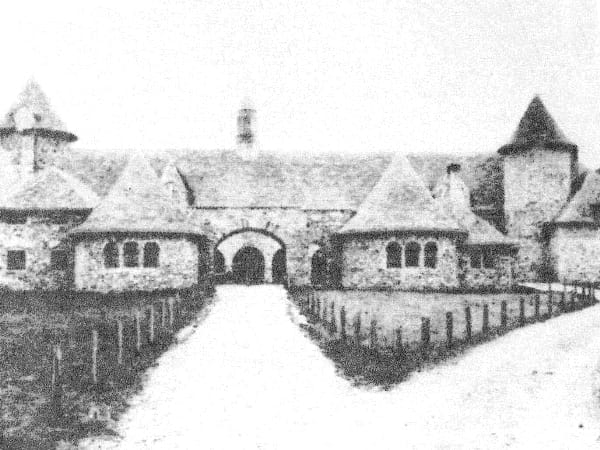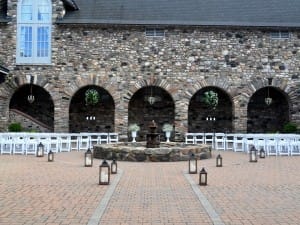“Abandon hope, all ye who enter here,” a sign attached to the Castle’s basement door once read. The sign is long gone, but the basement remains. And what used to be in it (and is still under it) will probably come as a surprise.
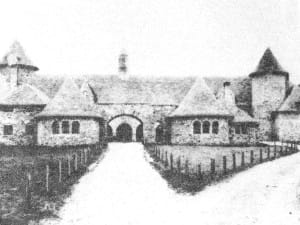 Loeb Farms (1918-1927) was built exactly where it stands today for one specific reason: the Castle is located directly atop an underground river (known more accurately as an artesian well). Albert Loeb, the Castle’s original owner, had more than 200 head of Holstein-Friesian dairy cows at the farm, and they needed drinking water. The artesian well provided a ready source. When underground water is tapped by a well, the pressurized water flows up to the surface. Loeb’s workers capped the artesian well, allowing water to flow directly through pipes into the barns. A steady stream of water flowing in the basement also provided natural refrigeration for all of the milk the cows were producing. In 1922, one of the cows, Marion, was the second largest producer of milk in the world. ‘Queen Marion’ had to be milked four times a day. Marion and the other cows all had their own personal watering troughs in the cow stanchions, courtesy of the artesian well.
Loeb Farms (1918-1927) was built exactly where it stands today for one specific reason: the Castle is located directly atop an underground river (known more accurately as an artesian well). Albert Loeb, the Castle’s original owner, had more than 200 head of Holstein-Friesian dairy cows at the farm, and they needed drinking water. The artesian well provided a ready source. When underground water is tapped by a well, the pressurized water flows up to the surface. Loeb’s workers capped the artesian well, allowing water to flow directly through pipes into the barns. A steady stream of water flowing in the basement also provided natural refrigeration for all of the milk the cows were producing. In 1922, one of the cows, Marion, was the second largest producer of milk in the world. ‘Queen Marion’ had to be milked four times a day. Marion and the other cows all had their own personal watering troughs in the cow stanchions, courtesy of the artesian well.
After Loeb Farms closed, the buildings 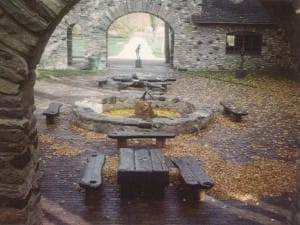 were abandoned. John VanHaver, the Castle’s 2nd owner (1962-1969), installed the ornate fountain which graces the Queen’s Courtyard today. He placed benches and other seats in the Courtyard so guests could enjoy the ambiance of the French castle. By 1969, out of money and time, VanHaver was forced to sell to 3rd owner Art Reibel. After Reibel erected the massive concert stage, legendary rock groups flocked to the Castle for live performances. The beautiful Courtyard fountain also was the scene of some live performances, depending on who you ask. Stories are still told about the various entertainers who used to cavort in the fountain once they finished performing on the Castle’s concert stage. That might be one reason Reibel decided to shut off the fountain.
were abandoned. John VanHaver, the Castle’s 2nd owner (1962-1969), installed the ornate fountain which graces the Queen’s Courtyard today. He placed benches and other seats in the Courtyard so guests could enjoy the ambiance of the French castle. By 1969, out of money and time, VanHaver was forced to sell to 3rd owner Art Reibel. After Reibel erected the massive concert stage, legendary rock groups flocked to the Castle for live performances. The beautiful Courtyard fountain also was the scene of some live performances, depending on who you ask. Stories are still told about the various entertainers who used to cavort in the fountain once they finished performing on the Castle’s concert stage. That might be one reason Reibel decided to shut off the fountain.
But an artesian well can’t be shut off for very long. The water has to bubble up somewhere. And as current owner Linda Mueller discovered in 2001, water doesn’t necessarily flow where you want it. When Linda bought the property, the basement was submerged under 5 feet of water. Her workers began the messy task of pumping out the basement, only to discover one foot of mud underneath the water. After months of hard work, the basement was finally cleared. Since it was impossible to keep the water out, Linda’s crew installed sump pumps. Keeping the basement dry, repairing the well pipes and installing a major draining system was one of the biggest projects of Linda’s restoration. She needed a solid foundation to make the buildings last for generations to come.
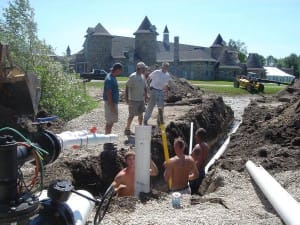
Nowadays, the Queen’s Courtyard Fountain provides a dramatic backdrop to the French architectural features of the Courtyard, as well as a lovely setting where bridal couples can exchange vows.
